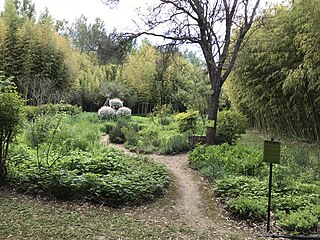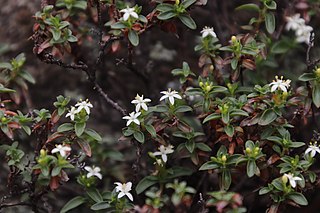
Philipp Franz Balthasar von Siebold was a German physician, botanist and traveller. He achieved prominence by his studies of Japanese flora and fauna and the introduction of Western medicine in Japan. He was the father of the first female Japanese doctor educated in Western medicine, Kusumoto Ine.

Rhodochiton is a genus of flowering plants within the family Plantaginaceae, native to southern Mexico and neighbouring Guatemala. They climb by means of twining leaf stalks. One of the three species, Rhodochiton atrosanguineus, the purple bell vine, is grown as an ornamental plant. All three species are sometimes included in Lophospermum.

Bamboo blossoming is a natural phenomenon in which the bamboos in a location blossom and become hung with bamboo seeds.

Ligustrum obtusifolium is a species of privet, native to Japan, Korea and northeastern China. The species is considered invasive in parts of the United States. It has become very common in southern New England, the mid-Atlantic States, and the Great Lakes regions, with scattered occurrences in the South, the Great Plains, and Washington state. With Ligustrum ovalifolium it is a parent of the widespread hybrid Ligustrum × ibolium.

The Parc aux Bambous is a botanical garden specializing in bamboo.

The Bambouseraie de Prafrance is a private botanical garden specializing in bamboos, located in Générargues, near Anduze, Gard, Languedoc-Roussillon, France. It is open daily in the warmer months; an admission fee is charged.

Bamboo shoots or bamboo sprouts are the edible shoots of many bamboo species including Bambusa vulgaris and Phyllostachys edulis. They are used as vegetables in numerous Asian dishes and broths. They are sold in various processed shapes and are available in fresh, dried, and canned versions.

Phyllostachys bambusoides, commonly called madake, giant timber bamboo, or Japanese timber bamboo, is a species of flowering plant in the bamboo subfamily of the grass family Poaceae, native to China, and possibly also to Japan.

Allium rothii is a plant species found in Israel, Palestine, Syria, Egypt, and Jordan. It is a perennial with umbel-shaped flowers that forms bulbs. Stamens and ovaries are noticeably deep purple, and the tepals are white with deep purple midveins..

Allium schubertii, which has various common names including ornamental onion, flowering onion, tumbleweed onion and Persian onion, is a species of monocotyledonous flowering plant. It belongs to the onion and garlic genus, in the subfamily Allioideae of the family Amaryllidaceae. It occurs in the Levant and Libya.
Allium erdelii is a plant species found in Israel, Palestine Lebanon, Syria, Iraq, Egypt, Libya and Jordan. It is a bulb-forming perennial with a small umbel of creamy-white flowers.

Sagittaria macrophylla, common name papa de agua, is an aquatic plant species. It produces underground starchy tubers. that are edible. It has large, hastate (arrow-shaped) leaves with blades up to 30 centimetres long. Terminal lobe is large and broadly lanceolate, while the two basal lobes are much smaller and narrower.

Otiophora is a genus of plants in the family Rubiaceae. There are approximately 20 species. Natural distribution range for the genus includes Madagascar and much of central and southern Africa from South Africa north to Tanzania and Nigeria.

Rhodochiton atrosanguineus is a herbaceous perennial vine native to Mexico. It has been cultivated as an ornamental plant since at least 1836.
Matelea lanata, synonym Trichosacme lanata, is a species of plants in the family Apocynaceae native to northeastern Mexico. When placed in the genus Trichosacme, it was the only species.
Myoporum bontioides is a species of the flowering plant in the family Scrophulariaceae. It is a shrub growing in coastal areas of southern Japan and South China including beaches and estuaries where there are no large breaking waves.
Solanum glaucescens is a species of flowering plant in the family Solanaceae and is endemic to Mexico. It is a deciduous vine with narrowly oblong to egg-shaped leaves 35–90 mm (1.4–3.5 in) long and 15–55 mm (0.59–2.17 in) wide on a petiole 10–40 mm (0.39–1.57 in) long. The flowers are arranged in groups of five to twelve on a peduncle 10–20 mm (0.39–0.79 in) long, each flower on a pedicel 5–10 mm (0.20–0.39 in) long but elongating to 30–40 mm (1.2–1.6 in) by the fruiting stage. The sepals form a bell-shaped tube 2–4 mm (0.079–0.157 in) long with five lobes. The petals are pale yellow to greenish, 20–40 mm (0.79–1.57 in) long and joined at the base with spreading, star-like lobes and there are ten to fifteen stamens. The fruit is a berry that is green at first, later turning orange.
Sceptrulophora is an order of hexactinellid sponges. They are characterized by sceptrules, a type of microsclere with a single straight rod terminating at a bundle of spines or knobs. An anchor- or nail-shaped sceptrule is called a clavule. A fork-shaped sceptrule, ending at a few large tines, is called a scopule. A broom-shaped sceptrule, ending at many small bristles, is called a sarule.

Euretidae is a family of glass sponges in the order Sceptrulophora.

Nymphaea gracilis is a species of waterlily endemic to Mexico. It is the only species of its genus, which is endemic to Mexico.















